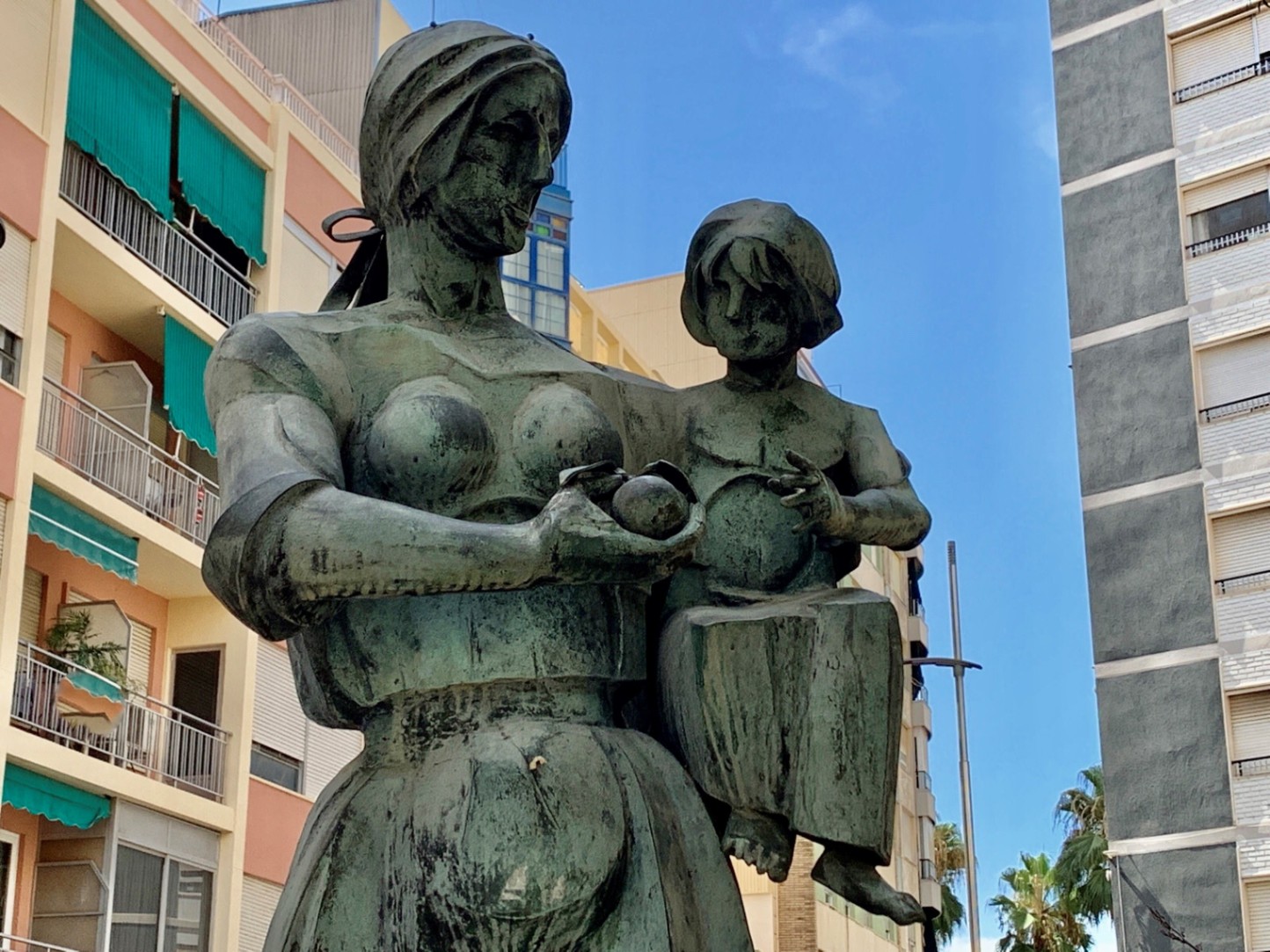Countries<Spain<Comunidad Valenciana<Alzira< Monumento a la Madre
Located in the garden between Avenida Sants Patrons and Calle Sucro is the monument to the mother, the work of the sculptor José Gonzalvo Vives, which was inaugurated on 6 May 2006.
This figure was donated to the city by Enrique Amat and Marisa Caro.
Mother's Day is one of the most special festivities we have in our calendar, and with the arrival of the month of May, thousands of homes take the opportunity to pay homage to all the mothers of the world. This festivity does not have a fixed day.
The origin of this festivity goes back much further than we can imagine. It was in Ancient Egypt, in 2,100 BC, where they began to worship the goddess Isis as 'the great mother goddess', although it was not until Ancient Greece that they began to worship Rhea, mother of Olympus.
This tradition was also adopted by the Romans, who went on to worship the goddess Cybele, the Mother goddess, for three days a year, to whom they brought flowers.
This date has not always been the one on which Mother's Day was celebrated, since in 1854, Pope Pius IX decided to establish December 8 as the day of homage to the Virgin Mary, defining it as the well-known day of the Immaculate Conception and also as Mother's Day. The United States decided to move its tradition to the month of May by choosing the second Sunday of this month.
The activist Julia Ward Home was one of the initiators of this day after a demonstration in Boston at the end of the 19th century in which she brought together all the mothers of families who were victims of the Civil War. As early as 1914, President Wilson Woodrow announced Mother's Day as an official celebration on the second Sunday in May, the date on which the mother of another of its promoters, Anna Reves Jarvis, died, and to whom he paid tribute every second Sunday in May.
In Spain, it took a little longer to change the date of Mother's Day as we know it today, as it was not until 1965 that it was decided to move it to the first Sunday in May. The reason for this change of date was none other than to separate festivities: on the one hand the day of the Immaculate Conception and on the other Mother's Day.
The fact that it is celebrated on the first Sunday in May also has its explanation, as May is the month related to feminine divinities in the classical world, and the month dedicated to the Virgin Mary in the Christian religion. Furthermore, it is also the month of maximum splendour of spring and when the countryside bursts into bloom, which is why flowers are usually given as gifts on this festivity.
Situado en el jardín que se encuentra entre la Avenida Sants Patrons y la calle Sucro se encuentra el monumento a la madre, obra del escultor José Gonzalvo Vives y que fue inaugurado el 6 de mayo del año 2006.
Esta figura fue donada por Enrique Amat y Marisa Caro a la ciudad.
El Día de la Madre una de las festividades más especiales que tenemos en nuestro calendario, y es que con la llegada del mes de mayo en miles de hogares se aprovecha para hacer un homenaje a todas las madres del mundo. Esta festividad no mantiene un día fijo, sino que su fecha puede variar de día al celebrarse el primer domingo de este mes.
El origen de esta festividad se remonta mucho más allá de lo que podemos imaginarnos. Fue en el Antiguo Egipto, en el 2.100 a.C., donde comenzaron a adorar a la diosa Isis como 'la gran diosa madre', aunque no fue hasta la Antigua Grecia cuando comenzaron a rendir culto a Rea, madre del Olimpo.
Esta tradición también la adoptaron los romanos, que pasaron a rendir culto durante tres días al año a la diosa Cibeles, la diosa Madre, a la que llevaban flores.
Esta fecha no siempre ha sido en la que se celebraba el Día de la Madre, ya que en el año 1854, el papa Pio IX decidió establecer el día 8 de diciembre como el día de homenaje a la Virgen María, definiéndolo como el conocido día de la Inmaculada Concepción y también como el Día de la Madre. Estados Unidos decidió pasar su tradición al mes de mayo escogiendo para ello el segundo domingo de este mes.
La activista Julia Ward Home fue una de las impulsoras de este día tras una manifestación en Boston a finales del siglo XIX en la que congregó a todas las madres de familia víctimas de la guerra de Secesión. Ya en 1914, el presidente Wilson Woodrow anunció el Día de la Madre como celebración oficial el segundo domingo de mayo, fecha en la que murió la madre de otra de sus impulsoras, Anna Reves Jarvis, y a la que homenajeaba todos los segundos domingos de mayo.
En España, tardamos un poco más en cambiar de fecha la festividad del Día de la Madre como lo conocemos en la actualidad, y es que no fue hasta 1965 cuando se decidió trasladar este día al primer domingo de mayo. El motivo de este cambio de fecha no fue otro que el de separar festividades: por un lado el día de la Inmaculada Concepción y por otro el Día de la Madre.
Que se celebre el primer domingo de mayo también tiene su explicación, y es que mayo es el mes que se relacionaba con las divinidades femeninas en el mundo clásico, y el mes dedicado a la Virgen María en la religión cristiana. Además, también es el mes de máximo esplendor de la primavera y donde irrumpe el florecimiento en el campo, razón por la que se suelen regalar flores en esta festividad.
